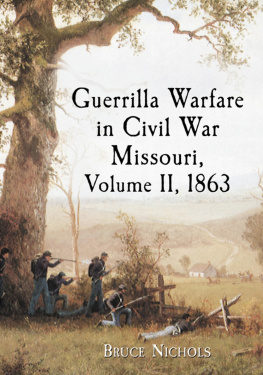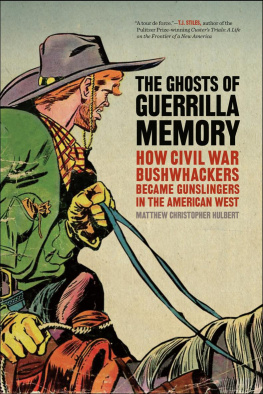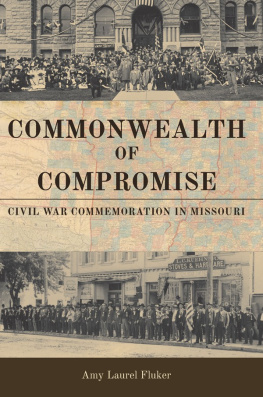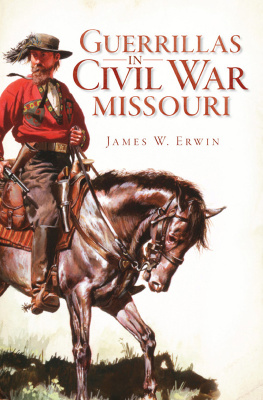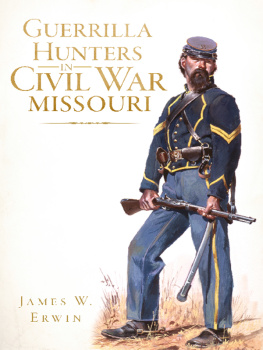
Also by BRUCE NICHOLS
Guerrilla Warfare in Civil War Missouri, Volume I, 1862
(McFarland, 2004; paperback 2012)
Guerrilla Warfare in Civil War Missouri, Volume II, 1863
BRUCE NICHOLS

McFarland & Company, Inc., Publishers
Jefferson, North Carolina, and London
LIBRARY OF CONGRESS CATALOGUING DATA ARE AVAILABLE
BRITISH LIBRARY CATALOGUING DATA ARE AVAILABLE
e-ISBN: 978-0-7864-9190-2
2007 Bruce Nichols. All rights reserved
No part of this book may be reproduced or transmitted in any form or by any means, electronic or mechanical, including photocopying or recording, or by any information storage and retrieval system, without permission in writing from the publisher.
Cover art 2012 PicturesNow.com
McFarland & Company, Inc., Publishers
Box 611, Jefferson, North Carolina 28640
www.mcfarlandpub.com
To our son Andy and our daughter Anna,
the pride and joy of our life,
who have given unending support and
encouragement in the production of this book
Preface
This work is an in-depth study of all known guerrilla operations in Missouri during 1863, the middle year of the Civil War, and the middle year of the darkest, most traumatic, terror-lled period in the history of the state. When I initiated active research for my work on guerrilla warfare in Missouri back in the middle 1980s, I envisioned one rather full volume covering this topic in enough detail to add something useful to the body of knowledge and provide a framework within which the curious could understand specic events and relationships both for reference and reading. When I began to analyze the vast quantities of material I amassed in several years of visiting libraries and historical societies, I discovered one volume could not contain this work. Fortunately, the seasonal nature of Missouris guerrilla war, in which action lessened considerably in the winter months, allowed me to divide my study of this topic into yearly increments without loss of too much transition.
I deliberately chose to begin this overall project with the rst day of the year 1862, and so my Guerrilla Warfare in Civil War Missouri, 1862, published by McFarland, was launched in spring of 2004. My long study of this topic convinced me that both northern and southern armies of the conict spent the year 1861 ghting to see whose military would occupy the state. The nature of guerrilla or irregular warfare is the secret, clandestine, or hidden resistance to an established power. The word guerrilla literally means little war, and that was just about how the Union and Confederate high commands regarded the warfare in Missouri after the northern forces ejected the southern ones in early 1862. Not until the winter of 1861/1862 were most Missouri southerners nally convinced that the Union military was the occupying power and their own military was about to be an army in exile. With that realization, a large number of men of southern sympathy began to seek ways to attack the despised Yankee occupation of their state. Therefore, although there were some southern guerrilla actions during 1861, these were mostly local southerners attacking passing Yankee troops, and the main military actions were the contests between the southern and north- ern regular forces. Only with the expulsion of the southern Missouri State Guard from its native soil in early 1862 did guerrilla warfare become the dominant form of ghting in Missouri. This volume is part of the study of that form of ghting for the year 1863.
An in-depth study of the protracted guerrilla warfare in Missouri has value for a variety of applications. I have empathy for descendants searching for their ancestors roles in this strange form of war so far removed from the more active theaters of the regular warfare. These researchers are often armed only with the who of their search and the when, where, and especially the why elude their grasp. Those searchers nd their rst great hurdle just nding which resources they need to use to begin the hunt. I also intend this book for enjoyable reading and the discovery of a troubled although neglected period of our nations history. Just about the only thing most Americans can recite from their education about guerrilla warfare in Civil War Missouri is the leader Quantrill, and if they can remember that he raided Lawrence, Kansas, they dont recall anything beyond that. Another more somber reason to study Missouri guerrilla warfare during that terrible war is the value our citizens can derive from the study of thousands of men and many women who resisted a Federal occupying force with some success for over four years. Even if their logistics and technology are relics of the past, how Missouri southern irregulars not only managed to survive overwhelming numbers but even kept the offensive for long periods of time may benet our current role in world affairs. The guerrillas of the 1860s did not call themselves terrorists, but terror and intimidation were among their greatest weapons in a war fought mostly with the grim, mutual understanding that prisoners would not always be taken.
Speaking of terms, in this work, as in the earlier one about 1862, I use the labels guerrilla, bushwhacker, irregular, and partisan all interchangeably to mean the same thing. I qualify such combatants as southern, Rebel, or Confederate to ensure the reader knows these are combatants of southern sympathy, since there was no need of northern guerrillas in a state under the occupation of northern troops. In some instances where I identify guerrillas who seemed to have no allegiance except robbery and personal gain I use such terms as renegades or freebooters. I resist the temptation to borrow from biased period sources such names for southern guerrillas as bandits, robbers, outlaws, and similar epithets since such words do not accurately portray these southerners warrior status. Similarly, I call northern combatants who forsook their duty and disgraced their uniform to plunder and murder renegades or even jayhawkers, the term particularly applied to some northern Kansas troops who engaged in revenge and plunder raids into western Missouri. Jayhawker may be a present-day admired and honored term to Kansans, but in terms of guerrilla warfare in Missouri of the 1860s it meant something much more sinister. A term I use sparingly is massacre, which in military subjects means an unwarranted, indiscriminate, merciless, and needless slaughter of a large number of human beings. Others use this term all too freely to mean a variety of things. In Missouri during the Civil War, the no quarter nature of guerrilla warfare complicated issues about what could and could not rightfully be called a massacre. Many southern military men returned from the South to Missouri many hundreds of miles behind Union lines and sought to enlist fellow southern men and bring them back to the Confederate army, and these I call recruiters to distinguish them from the guerrillas. This distinction is sometimes hard to make since southern recruiters used local bushwhackers as security forces, and men who at times during the war acted as recruiters seemed to act at other times as guerrillas. The Confederate government and military freely used their own term partisan rangers to protect the status as legitimate combatants of both their guerrillas and recruiters. The Union military leadership disputed such a loose granting of legitimacy to what they considered brigands, thieves, assassins, and the like, and was always loathe to recognize as lawful combatants southerners who wore no uniforms, refused most of the time to face combat in the open, and who seemed to answer to no rightful chain of command. Therefore, period sources reect this confusion of terms to the southerners who fought in guerrilla warfare. Northern combatants I call Union, Yankees, or Federals, although I reserve this last term for northern troops on active status in federalized units and not local militia or home guards. Wherever possible, I make distinctions in this work between the different types of northern militia in the bewildering array of militia that Missouri authorized at different times during the war. This is not only for historic precision, but to show the reader how the different training, leadership, and experience levels of these different units affected their behavior in the eld.
Next page
